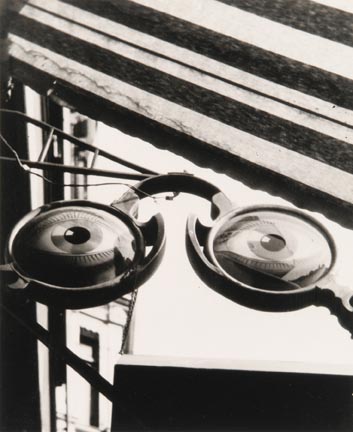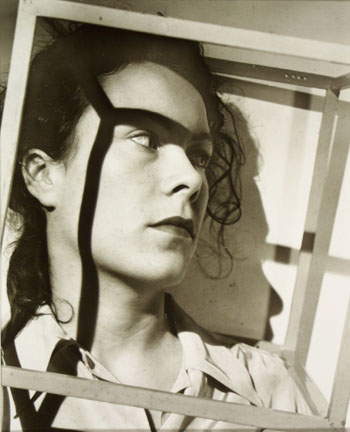About the Photographer
Kepes, Gyorgy
American, 1906-2001 b. Hungary
Throughout his career Gyorgy Kepes played many roles, often interchangeably, and he was influential as a designer, photographer, painter, writer, and educator. Born in Selyp, Hungary, Kepes studied painting at the Royal Academy of Fine Art in Budapest from 1924 to 1928. He began experimenting with photography while he was a student, and he maintained a passionate interest in the medium throughout his life. An untitled photograph from 1927, held in MoCP's collection, foreshadows Kepes' ongoing fascination with optics and shows his early engagement with photographic abstraction, which he would purse actively in later years. The image centers on an optometrist's sign depicting a pair of spectacles, but the photograph's framing effectively separates it from its environment, creating a pair of floating eyes. Meanwhile, Kepes reduces the immediate surroundings to formal elements: a pair of black rectangles anchor the left and bottom edges of the image, and alternating bands of black and gray cut through the top third at a diagonal. Juxtaposing the piercing eyes with abstracted, graphic shapes may be read symbolically, pointing to photography's function as a mediator between our eyes and the world.
Between 1930 and 1936, Kepes went to work in the studio of László Moholy-Nagy, first in Berlin and then in London. Moholy-Nagy had resigned from his position as an instructor at the Bauhaus, the famous German design school, and was concentrating on film and stage design. However, he continued to believe in what he dubbed "the New Vision," namely that photography could create a new way of seeing the world. After Moholy-Nagy became the founding director of the New Bauhaus in Chicago (later renamed the Institute of Design), Kepes was invited to head the school's Color and Light Department, and he immigrated to the United States. During this period, Kepes shifted away from using thematic motifs of vision in his imagery toward investigations related to the mechanics of vision and the visual phenomena of light. The beginnings of this may be seen in Juliet's Shadow Caged (1939 or 1941), a photograph in which Kepes' wife wears a three-dimensional frame that casts an angular shadow across her face. The frame and her head also cast shadows on the wall behind her, and this play of shadows and structural forms amounts to both a study of light and a symbolic arrangement, as suggested by the title. After leaving the Institute of Design in 1944, Kepes published his hugely influential book Language of Vision, concerning his teaching and philosophy of design and representation. The book led many students to study at the Institute of Design and was used as a college textbook for many years.
In 1946 Kepes began teaching visual design at the Massachusetts Institute of Technology, where he later initiated and edited the six-volume book series Vision + Value (1965-1966) to encourage interdisciplinary cooperation among artists, scientists, and scholars on the role of vision in human knowledge and expression. In 1967 Kepes founded the Center for Advanced Visual Studies at MIT. The new center was devoted to integrating art with technology, a longstanding interest for Kepes, and it created a forum for collaboration among artists, designers, scientists, and engineers. Kepes directed the Center until 1972, and it continues to operate today. Kepes received numerous awards over the course of his career, including a Guggenheim Fellowship (1959-1960), and his work has been exhibited widely. His relationship to Moholy-Nagy and his role in the Institute of Design is documented in Taken by Design: Photographs from the Institute of Design, 1937-1971 (2002).




